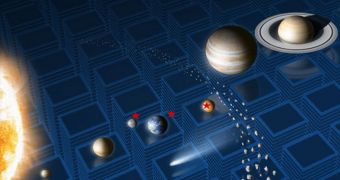For the first time ever, NASA experts at the Goddard Space Flight Center, in Greenbelt, Maryland have operated three scientific experiments of the same type at three different locations throughout the solar system. All experiments were mass spectrometer instruments, which can identify the molecules making up samples of almost any material.
The achievement took place on December 4, when the mass spectrometers on the Mars Science Laboratory (MSL) rover Curiosity, the Lunar Atmosphere and Dust Environment Explorer (LADEE) orbiter and the Mars Atmosphere and Volatile Evolution (MAVEN) mission ran simultaneously.
Mass spectrometers can take nearly any kind of material sample, from air to soils and rocks, and break it apart into its constituents. Over the years, these instruments have become invaluable for studying other planets, moons, and asteroids in the solar system.
When these tools are installed on spacecraft, they are usually accompanied by a host of other scientific instruments; Curiosity, for example, as a total of 10 instruments. However, on Wednesday, schedules for all three missions coincided in their use of their three respective spectrometers
“At the Moon and Mars and part way in between, we had three mass spectrometers happily operating in their other-worldly environments or being checked out for the first time in space on the same day,” says the principal investigator for the instruments, GSFC expert Paul Mahaffy.
His Planetary Environment Laboratory at Goddard was responsible for building all three mass spectrometers. “With these studies, mass spectrometry is helping us piece together the histories of the moon and Mars and offers a vision of their futures,” Mahaffy explains.
At the Moon, LADEE was using its Neutral Mass Spectrometer for complex studies of the lunar atmosphere, which is much thinner than Earth's. The instrument is even now collecting samples at several points in its low orbit around Earth's natural satellite.
Further away, on its 10-month trek to Mars, the MAVEN orbiter opened its Neutral Gas and Ion Mass Spectrometer instrument for the first time. Mission controllers conducted a series of tests with the tool, meant to calibrate it by studying sample gases pre-packaged into the instrument's detectors.
On Mars, Curiosity's Sample Analysis at Mars (SAM) instrument suite is investigating multiple types of samples for potential signs that the Red Planet was once suitable for the development of life.

 14 DAY TRIAL //
14 DAY TRIAL //